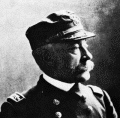Click On Image
For Full Size Image |
Size |
Image Description |
Contributed
By |
 |
25k | Bowman H. McCalla, born 19 June 1844 at Camden, N.J., was appointed midshipman 30 November 1861 . McCalla’s courage and leadership during his career often earned him great, and due, respect among his fellow officers. In the spring of 1885 he led an expeditionary force of 750 seamen and marines which landed at Panama to protect American treaty rights as a revolution there threatened to block transit across the isthmus. As commanding officer of Marblehead (q.v.), 11 September 1897 to 16 September 1898, he took part in the blockade of Cuba and was responsible for the cutting of submarine cables linking Cienfuegos with the outside world, thus isolating the Spanish garrison there, May 1898. While in command of Newark during the Boxer Rebellion 2 years later, he was cited for conspicuous gallantry in battle as he led a force of bluejackets from Tientsin to Peking. McCalla’s force of 112 men spearheaded an international column, under British Admiral Seymour, which was attempting to fight its way to the aid of foreign legations under seige at Peking. In the course of the battle at Hsiku Arsenal, McCalla, along with 25 of his force, was wounded; five were killed. Commissioned rear admiral 11 October 1903, he served as the Commandant of Mare Island Naval Shipyard. He entered on the retired list 19 June 1906, McCalla died 6 May 1910 at Santa Barbara, Calif., and was buried in Arlington National Cemetery. | Darryl Baker/Robert M. Cieri/Bill Gonyo |
 |
90k | Underway, circa the early 1920s. | Marc Piché/Robert Hurst |
 |
45k |
Two views of McCalla very early in her service (note her hull number does not yet have the shading, indicating 1920). From a photo album of W.F. Mosier (presumably
William Franklin Mosier, service # 262 10 09, enlisted 5 May 1920). |
Dave Wright |
 |
71k |
On British Service
|
| HMS Stanley's RN career commenced somewhat inauspiciously when defects forced her to return to St Johns, NF, during her initial passage. Repairs at St Johns delayed her from 6 November to 13 December 1940, and she did not finaly make Devonport until 2 January 1941, having been further delayed at Belfast. Once taken in hand at Devonport, it was decided that the scale of work needed was such as to justify her inclusion with HMS Bradford and HMCS Clare in the first Long Range Escort programme. Accordingly she was gutted amidships with the two forward boilers being replaced with bunkers and store, etc, a new bridge structure extended aft to the two after funnels, and she was fitted with Type 271 radar and centreline torpedo tubes. When completed in September 1941 she was one of the more potent A/S escorts available. Because of her increased range, HMS Stanley was allocated initially to the Liverpool Sloop Division to escort convoys on the OS/SL cycles to and from Sierra Leone. She then transferred to the 40th Escort Group where she came under the command of Captain Walker, who was to make his name as the pre-eminent submarine hunter of the war. With 40th Escort Group and under Captain Walker's overall command, HMS Stanley was one of the escorts for convoy HG76 from Gibraltar, the first convoy to have a properly organised and trained Escort Group and escort carrier with it, and the first to be fought through against a concerted submarine attack by such a combination. In the confused fighting around the convoy from 17 to 19 December 1941, HMS Stanley alongwith the escort destroyers HMS Blakeney and HMS Exmoor, sloop HMS Stork, corvette HMS Pentstemon, alongwith aircraft of No. 802 Sqd, FAA operating from the escort carrier HMS Audacity sank U131 on 17 December. On the following day HMS Stanley and the escort destroyer HMS Blakeney sank U434 south-west of Cape St. Vincent. HMS Stanley was lost to U574 on 19 December with the loss of all but 25 of her crew. Revenge was immediate, U574 being sunk by the sloop HMS Stork within minutes of HMS Stanley's loss. Brief though HMS Stanley's career was, she demonstrated both the validity of the Long Range Escort concept, and also the effectiveness of a properly trained and led Escort Group with carrier support. (Foreign service history thanks to Robert Hurst) |
 |
78k | Undated, HMS Stanley (I.73) underway in Plymouth Sound, after her conversion to a long range escort. Photo # FL 3349 from the collections of the Imperial War Museum. | Robert Hurst |
 |
85k | As the HMS Stanley in Plymouth, England 1941. | Marc Piché |
 |
99k | HMS Stanley (ex-USS McCalla, DD-253) shortly after an air raid on Devonport, 28/29 April 1941. The stripped hulk of the ship is shown in the later stages of her conversion to a Long Range Escort. Note the base of the new bridge structure can be seen, presumably the stripping out of the boiler rooms has already been done in dry dock (Admiralty Official). | Robert Hurst |
 |
77k | HMS Stanley after the completion of her conversion to a Long Range Escort at Devonport (Admiralty Official). | Robert Hurst |


 To Britain October 23 1940, renamed HMS Stanley (I73).
To Britain October 23 1940, renamed HMS Stanley (I73).